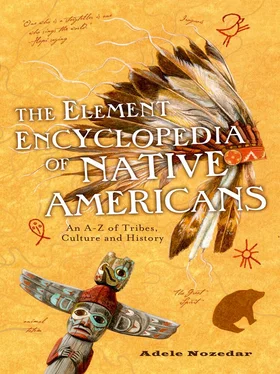1 ...7 8 9 11 12 13 ...30 A progressive leader, there were many facets of the new culture of America that Big Elk thought were good, and he was happy to have two of his daughters marry successful fur traders since he believed that assimilationcould work well for both parties, and that such illustrious sons-in-law would give credence to his own family. Since the Omaha tribe followed a matrilinearsystem, any offspring would be automatically accepted as tribal members.
One of these “good” marriages came with the betrothal of Big Elk’s daughter, named Mitain, to the Governor of the Missouri Territory, Manual Lisa, even though he was at the time still married to a white woman who had been left behind in St. Louis.
Big Elk’s daughter Me um Bane married a wealthy fur trader named Lucien Fontanelle. Their eldest son, Logan, worked as a translator for the U.S. Indian agent from the age of 15. Logan went on to become an important person within the tribe because of his abilities, especially in negotiating land deals, although he was unfortunately killed by the Sioux.
Big Elk believed that, in ceding land to the Government, his people would receive protection in exchange. Accordingly, the tribe gave up most of their land and were relocated onto a reservationin the northeastern part of Nebraska. At this time Big Elk adopted another fur trader, Joseph LaFlesche, not only into the tribe but as his son. In 1842 Big Elk informed Joseph that he would succeed him as chief, and so the young man began to train himself in the traditional ways of the tribe.
Big Elk died in 1846, after a fever. He is buried in Nebraska, at a site known as Elk Hill but also known to the Omaha people as Ong-pa-ton-ga Xiathon , meaning “The Place Where Big Elk Is Buried.”
1836(?)–?
As a young Pawneebrave of 15 or 16 in 1852, Big Spotted Horse was chased by a Cheyennewarrior while taking part on a buffalohunt in Kansas. The warrior, Alights on the Clouds, wore a protective material called scalemailwhich meant that he was impervious to arrows. Alights on the Clouds intended to count coupon Big Spotted Horse, and galloped toward his right hand side. What he did not know, however, was that Big Spotted Horse was left-handed; he turned to the right as Alights on the Clouds approached him with a sword, pulled back his bow, and struck home, piercing his enemy’s eye.
The young Big Spotted Horse had no idea what had happened until some of his fellow Pawnee hunters, seeing the body fall, shouted out. The Cheyenne, shocked at the death, retreated, but for the Pawnee, the killing of a warrior decked in protective metal discs was celebrated as a great victory. Big Spotted Horse’s name as a great warrior was made, and his exploits as a horsethief and warrior became the subject of folklore.
In one raid, in 1869, he led his men to a Cheyenne village near a river. There they stealthily untied the choicest horses, setting off for home with some 600 animals. Despite blizzards, they made it home intact to their village. However, horse raiding was very much frowned upon by the Indian agents, and 600 horses were too many to hide from Jacob Troth. Big Spotted Horse was called before him and ordered that the horses should be returned to the Cheyenne. Big Spotted Horse, determined not to be humiliated by such an action, refused, and was imprisoned. After five months he was released, however, when it was proved that there was no statute that made horse raiding illegal.
On returning to his village, Big Spotted Horse was outraged to find that only some 40 of the horses remained, the rest having been returned whence they came. In his anger, he joined the Wichitapeople in Oklahoma.
In 1872 Big Spotted Horse returned to his village with the intention of relocating his entire tribe to the Wichita territory, a move supported by them but disapproved of by the Pawnee chiefs, who did not want to leave. So Big Spotted Horse gathered some 300 supporters and returned to the Wichita; two years later, to the dismay of the Pawnee chiefs, the rest of the tribe followed him, despite the fact that the Wichita land was far less fertile than that of Nebraska.
The Chippewahword for the resins obtained from certain evergreen trees including the cedar and various firs. Bigiu was used to make things waterproof: rafts and canoes, basketware, etc. It was also used to coat the ends of sticks which could then be set alight so that hunters could hunt at night.
See also Glue
1810(?)–1859
Also known as the “Alligator Chief,” Billy Bowlegs’ name in the language of his Seminoletribe was Holata Micco , meaning “chief.”
Billy was born in the Seminole village of Cuscowilla, in the part of the U.S. which is now Paynes Prairie, Florida. His family, the “Cowkeeper Dynasty,” were the hereditary chiefs of the Seminole; among his relatives was King Bowlegs, who was head chief at about the time that Billy would have been born. Billy became chief in 1839 after the old chief, Micanopy, was forced west into exile during the Second Seminole War and thereby forfeited his right to remain chief.
Billy remained chief during the Second and Third Seminole Wars, fought against the U.S. In 1832, on behalf of his tribe, he signed a treaty to agree that the Seminole would relocate west if suitable land were found for them. Land was found, but the tribe, under Billy, refused to quit Florida, and shortly afterward the Second Seminole War broke out. This war resulted in the deaths of many Seminole, including other leaders, and Billy and a small band of 200 warriors were among the few survivors. They lived peacefully for some 20 years until, in 1855, a group of white men who were surveying the territory built several forts in the area after destroying property and chopping down valuable banana trees. The Third Seminole War broke out as Billy Bowlegs and his men led a series of guerrilla attacks on the invaders. This war lasted for three years until, in 1858, Billy was approached by the chief of the Western Seminole, Wild Cat. Wild Cat had been sent to try to persuade Billy and his band to relocate; faced with an offer of hard cash, the 124 Seminole, including their leader, agreed to move to the Indian Territory. Billy died shortly after the journey there.
The Biloxi people belong to the Siouxan language family, although their actual dialect is no longer spoken; the last speaker died in the 1930s. Originally they lived near the Gulf of Mexico close to the city that is named for them—Biloxi, Mississippi. The tribe were descended from the mound-building people.
When they were first “discovered” by a French Canadian explorer in 1699, Pierre Le Moyne d’Iberville was told that the tribe had been quite large before they suffered the ravages of smallpox.
The Biloxi were a farming people who supplemented their agricultural efforts with fishing and hunting; their prey included buffalo, deer, and sometimes bear. The Biloxi society had as its head the Great Sacred One, effectively the monarch, who could be a king or a queen but was always a shamanor spiritual practitioner. In the Biloxi language he or she was called the Yaaxitqaya ; nobles below the Yaaxitqaya were called ixi . The tribe lived in cabins made of packed mud and bark.
The Biloxi had unusual funeral practices. The deceased were dried out by means of smoke and fire and then tied to red-painted poles which would be sunk vertically into the ground in the center of the temple.
Читать дальше












